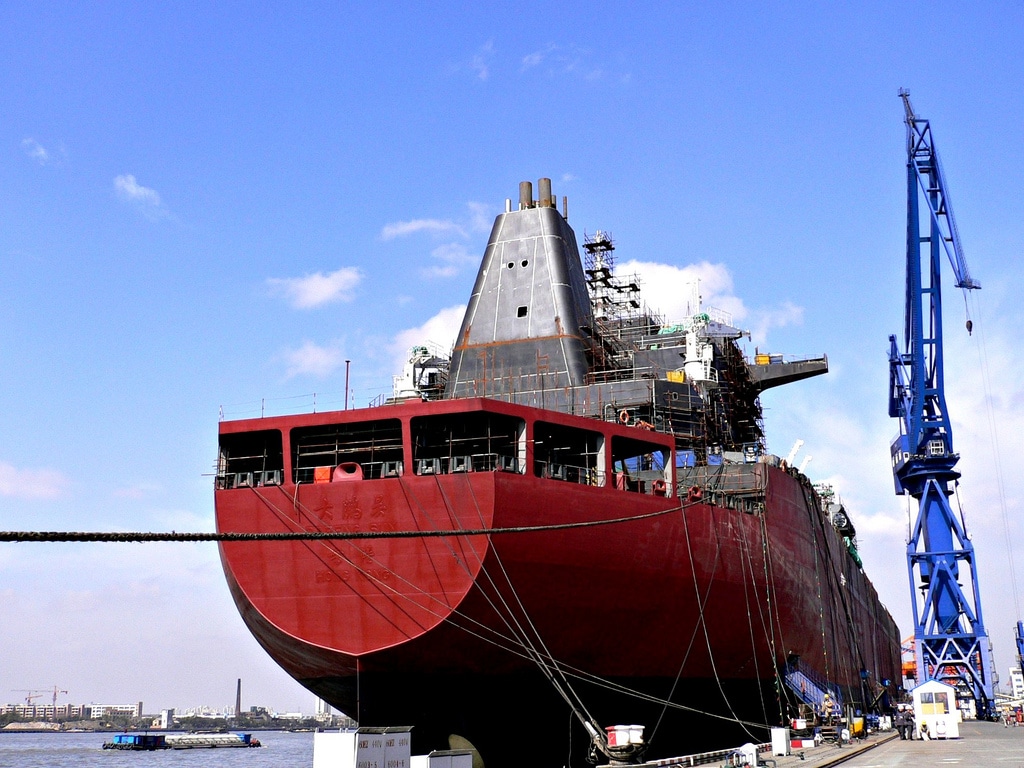Last year, a wave of bankruptcies swept the oil and gas drilling industry as oil prices collapsed, leading to layoffs, lost revenues for communities, and turning former boomtown-era mancamps into ghost towns in places like North Dakota’s Bakken shale.
Even before oil prices plunged, the price of shale gas was already under siege from a domestic supply glut caused by the shale drilling frenzy. All told, prices dropped from its all-time high of over $15/mcf when the shale boom began in 2005 to $1.57/mcf — the lowest levels since 1998 — in March.
For shale exploration and production companies, however, the conventional wisdom has held for years that there is a light at the end of the tunnel — gas exports.
Unlike oil, natural gas is difficult to transport across oceans. To ship gas by tanker, it needs to be cooled to below -256 degrees Fahrenheit, an expensive and technologically challenging process, requiring the construction of multi-billion dollar Liquefied Natural Gas (LNG) import and export terminals.
Once those terminals were built, the international market could soak up the shale gas supply glut, allowing drillers to make handsome profits for their investors and to keep rig workers employed for years to come, shale boosters predicted.
In February, the first ever export of LNG from shale gas reached Brazil, leaving from Cheniere Energy’s Sabine Pass terminal in Louisiana. Last month, a second shipment of American shale gas reached India — but that gas sold for just roughly $5/mcf at the Dabhol LNG import terminal there.
In other words, unfortunately for the shale drilling industry, those new shale exports are entering a world market that is also suffering from its own sudden collapse in prices.
LNG prices hit 18-year lows this month, in part due to collapsing demand from China and other Asian countries for commodities and in part because other countries have also invested heavily in building export facilities at the same time as the U.S..
“U.S. LNG will materialize at a time when the biggest market (Japan) is witnessing a demand reduction and when supply is growing again massively thanks to Australia,” said Thierry Bros, senior gas analyst at Societe Generale, told Reuters in October. “This is the worst possible timing for this new LNG that has no dedicated market.”
Before the shale rush, companies spent billions building import terminals, only to suddenly face a domestic supply glut that abruptly made American-drilled gas cheaper than LNG from overseas. “Ten years ago, we thought we were facing a gas shortage and we built all of these facilities to import natural gas,” Frank Wolak, a Stanford University energy expert, told the Los Angeles Times in 2014. “Now they are all sitting idle.”
Now, it seems, the LNG industry may once again be facing a sudden and unexpected reversal.
“Just two years ago, exporting LNG from the U.S. sounded like a lucrative opportunity for shale drillers. Buyers in Northeast Asia were paying up to $20 per million British thermal units more than spot Henry Hub gas prices,” Bloomberg reported in March. “That premium has collapsed, this week trading around $2.70.”
And since the process of liquefying the natural gas and shipping it carries additional costs — potentially enough to eat through all of the higher price that LNG commands in some international markets — that’s bad news for the shale drilling industry, already under enormous financial pressure from the collapse of oil prices by roughly two thirds since 2014.
Since the start of last year, over 50 North American oil and gas producers have filed for bankruptcy. But the oil and gas has continued to flow (in part because even when drillers go bankrupt, their existing wells are usually left in production by their creditors).
Those who expect that LNG exports will reverse the fortunes of shale gas drillers may be in for a rude awakening. “The low and volatile energy price environment is forcing developers to tighten belts and we can expect more proposed projects to delay investment decisions,” James Taverner, a Tokyo-based analyst at IHS Inc., told Bloomberg. “There are far more LNG projects competing to go ahead than the market can absorb.”
That’s a very different story than the one oil and gas industry lobbyists are pushing in Washington D.C, where some have claimed that nearly a half a million jobs could be supported by gas exports. “LNG exports could contribute up to 452,000 jobs nationwide between 2016 and 2035 and add up to $73.6 billion annually to the GDP, according to an ICF International study,” Jack N. Gerard, president and CEO of the American Petroleum Institute wrote in February. “Policies currently pending in Congress to expedite and establish greater certainty in the LNG export permitting process are essential to further capitalize on our position as the world’s leading natural gas producer.”
The reality? The prospects from LNG have soured so fast that shale gas sellers may struggle to find buyers at prices that will allow them to turn a profit. “Regulators this month rejected Veresen Inc.’s request to build a terminal in Oregon partly because it couldn’t prove there was enough demand,” Bloomberg reported in March.
Of course, some analysts saw the supply glut and price collapse coming. “The latest free lunch being peddled involves exporting U.S. natural gas. Don’t be surprised if it evaporates,” Wall Street Journal reporter Liam Denning warned in 2012, explaining that domestic gas futures ran at $3/mcf, while the international market paid as high as $17/mcf. “That spread is why companies such as Cheniere Energy are racing to build plants to export U.S. gas. But if ‘$3 in, $17 out’ sounds too good to be true, that is because it is. While the economics of exports can make sense, they are no slam-dunk.”
The Heartland Institute, best known for its climate denying extremism, has also been hyping LNG exports. “The export of U.S.-produced natural gas marks the emergence of America as an energy-rich nation,” James Taylor, senior fellow with The Heartland Institute, wrote this week. (As DeSmog earlier reported, Heartland’s “2012 Fundraising Plan” showed the pro-coal think tank planned to “raise funds from businesses with a financial interest in fracking” by “approach[ing] dozens of companies and trade associations that are actively seeking allies in this battle.”) “For years, we behaved and suffered as an energy poor nation due to our poor political choices,” Mr. Taylor continued.
But the geopolitical leverage that the industry has touted in Washington D.C. will only emerge if American exports indeed can be delivered cheaper than gas out of, say, Qatar (currently the world’s largest LNG exporter). “The fact that Qatar owns the value chain from start to finish allows it to have a level of efficiency that is going to be tough for other producers to match,” Allison Wood a Control Risks Group Ltd. official, told Bloomberg in January.
Of course, the paradox here for investors in U.S. LNG exports is that LNG terminals are notoriously time-consuming to construct – and a lot can change during that lead time. In March, a group of analysts at Wood Mackenzie warned that “average utilisation of US LNG export capacity between 2017-20 could vary from 54-100%” – in other words, that virtually half of the LNG plants expected to come online in the next few years could wind up mothballed, depending on what direction coal and gas prices swing.
On the other hand, the low LNG prices of today could be followed by sudden gas price spikes, if companies drop construction plans and LNG supplies run short over the long-run, Wood Mackenzie analyst Saul Kavonic told Bloomberg.
And that possibility makes LNG a risky bet for buyers as well.
Even the most seasoned investors have stumbled when trying to predict the prospects of natural gas. According to Forbes, famed investor Carl Ichan lost over $1 billion by placing a poorly-timed bet on Chesapeake Energy, America’s second-largest supplier of natural gas, which has seen its stock price collapse from over $66 a share to single digit levels over the past eight years — in part due to the domestic supply glut that the company helped create.
The erratic swings of shale gas and LNG prices reflect the volatile and unpredictable nature of the oil and gas industry, calling into question the wisdom of building more fossil fuel infrastructure that could wind up trapping consumers into buying fuel that not only brings with it costly global warming impacts, but also a sticker shock when electrical and home heating bills arrive.
Of course, individual companies can protect themselves against volatility by inking long-term contracts — but experts say that the long-term market is becoming more difficult to predict, making both sides of the deal commitment-shy. When Reuters asked the owners of LNG plants under construction about their exposure to price-shift risks, only two out of the five companies said they had long-term agreements in place.
This uncertainty already has federal regulators concerned. In March, the Federal Energy Regulatory Commission refused to grant permits for the construction of the Jordan Cove LNG terminal planned in Oregon, in part because the company lacked contracts proving that it could sell that LNG. (On Friday, Veresen and the Williams pipeline company, which backed the Jordan Cove project, filed a request for a rehearing by FERC.)
Environmentalists in Texas immediately took note, saying that the Oregon plant’s rejection showed that the adverse impacts on communities outweighed any public benefit from exports. “Rio Grande LNG is boasting about its non-binding contracts, and Annova and Texas LNG exude confidence that they will be able to sell their LNG overseas, but that’s clearly not enough for FERC approval, especially since we can show how damaging these projects would be,” Jim Chapman, chair of the Lower Rio Grande Valley Sierra Club, said in statement when the Oregon permit was turned down.
Still, companies are pressing forward with an aggressive LNG buildout.
“As of December 4, 2015, the U.S. Department of Energy (DOE) had approved only 16 applications for permits to export liquefied natural gas (LNG) to non-free trade agreement nations,” the American Petroleum Institute indicates on its website, where they have created an online map showing the locations of each planned project. “There are currently 28 pending applications where U.S. businesses are seeking approval to build and operate terminals to process LNG for sales abroad.”
Photo Credit: LNG Carrier, by Herry Lawford, via Flikr.
Subscribe to our newsletter
Stay up to date with DeSmog news and alerts







